Marc Abrahams's Blog, page 245
October 15, 2016
Video of the peace prize winner discussing bullshit and people who crave bullshit
The 2016 Ig Nobel Peace Prize was awarded to Gordon Pennycook, James Allan Cheyne, Nathaniel Barr, Derek Koehler, and Jonathan Fugelsang for their scholarly study called “On the Reception and Detection of Pseudo-Profound Bullshit”.
The study is: “On the Reception and Detection of Pseudo-Profound Bullshit,” Gordon Pennycook, James Allan Cheyne, Nathaniel Barr, Derek J. Koehler, and Jonathan A. Fugelsang, Judgment and Decision Making, vol. 10, No. 6, November 2015, pp. 549–563. The authors were all at the University of Waterloo. Nathaniel Barr is now at at Sheridan College, Gordon Pennycook at Yale University.
Gordon Pennycook, Nathaniel Barr, Derek Koehler, and Jonathan Fugelsang attended the Ig Nobel Prize ceremony at Harvard University. Two days later, at the Ig Informal Lectures, at MIT, Nathaniel Barr gave this five-minute talk. The video here also includes his subsequent Q & A with the audience:

The Benefits of a Lending Library for Female Urinals
Libraries can have many benefits. This paper outlines one:
“The Benefits of a Lending Library for Female Urinals,” Julie Vickerman, Nursing Times, vol. 99, no. 44, 2002, pp. 56-57. The author is at the Chorley and South Ribble Primary Care Trust, Lancashire, UK.
Here’s detail from the paper:


October 13, 2016
The Human Chin – an enduring puzzle
“Despite the vast amount written on the chin, it is deserving of continued attention, for perhaps understanding the chin will reveal some unexpected insight into what it means to be human.”
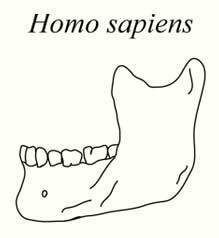 – explain Dr James D. Pampush (Duke University, US) and Dr David J. Daegling ( University of Florida, US). They add to the literature on the subject, with a comprehensive review of current chin-formation theory for the journal Evolutionary Anthropology:(News, and Reviews,) Volume 25, Issue 1, January/February 2016, pages 20–35 :
– explain Dr James D. Pampush (Duke University, US) and Dr David J. Daegling ( University of Florida, US). They add to the literature on the subject, with a comprehensive review of current chin-formation theory for the journal Evolutionary Anthropology:(News, and Reviews,) Volume 25, Issue 1, January/February 2016, pages 20–35 :
“Although modern humans are considered to be morphologically distinct from other living primates because of our large brains, dexterous hands, and bipedal gait, all of these features are found among extinct hominins. The chin, however, appears to be a uniquely modern human trait. Probably because of the chin’s exclusivity, many evolutionary scenarios have been proposed to explain its origins. To date, researchers have developed adaptive hypotheses relating chins to speech, mastication, and sexual selection; still others see it as a structural artifact tangentially related to complex processes involving evolutionary retraction of the midfacial skeleton. Consensus has remained elusive, partly because hypotheses purporting to explain how this feature developed uniquely in modern humans are all fraught with theoretical and/or empirical shortcomings.”
“Chins, probably because of their status as a modern human autopomorphy, continue to generate a great deal of interest among evolutionary anthropologists and biologists. Yet none of the proposals purporting to explain why this unusual feature occurs in modern humans (and only modern humans) is without problems. […] This should serve as motivation, not discouragement, for researchers to continue investigating this modern human peculiarity.”
See: The enduring puzzle of the human chin
Also see: Teflon Chins
Bonus assignment [optional]: How much could you write on your chin?

October 12, 2016
A Financial Times-ly look at the prizes
Tim Harford wrote a lovely essay in the Financial Times, about the Ig Nobel Prizes. Here’s a chunk of it:
The Ig Nobel prizes: in praise of ridiculous research
…one of the Ig Nobel’s charms is that this ridiculous research might actually tell us something about the world. David Dunning and Justin Kruger received an Ig Nobel prize in psychology for their discovery that incompetent people rarely realise they are incompetent; the Dunning-Kruger effect is now widely cited. Dorian Raymer and Douglas Smith won an Ig Nobel in physics for their discovery that hair and string have a tendency to become tangled — potentially an important line of research in understanding the structure of DNA. Most famously, Andre Geim’s Ig Nobel in physics for levitating a live frog was promptly followed by a proper Nobel Prize in the same subject for the discovery of graphene.
A whimsical curiosity about the world is something to be encouraged. No wonder that the credo of the Ig Nobel prizes is that they should make you laugh, then make you think. In 2001, the Ig Nobel committee did just that, awarding the economics prize to Joel Slemrod and Wojciech Kopczuk, who demonstrated that people will try to postpone their own deaths to avoid inheritance tax. This highlights an important point about the power of incentives — and the pattern has since been discovered elsewhere.
Alas, most economics Ig Nobel prizes provoke little more than harsh laughter. They’ve been awarded to Nick Leeson and Barings Bank, Iceland’s Kaupthing Bank, AIG, Lehman Brothers, and so on. The first economics prize was awarded to Michael Milken, one of the inventors of the junk bond. He was in prison at the time.
Fair game. Still, surely there is something in economics that is ludicrous on the surface yet thought-provoking underneath? (The entire discipline, you say? Very droll.)…

“Symmetry-breaking phase transitions in highly concentrated semen” [study]
Non-scientists can introduce themselves to the concept of symmetry-breaking by reading this newly published study by Creppy and colleagues:
“Symmetry-breaking phase transitions in highly concentrated semen,” Adama Creppy, Franck Plouraboué, Olivier Praud, Xavier Druart, Sébastien Cazin, Hui Yu, Pierre Degond, Journal of the Royal Society Interface, epub October 12, 2016. The authors write:
Depositing fresh semen sample in an annular shaped microfluidic chip leads to a spontaneous vortex state of the fluid at sufficiently large sperm concentration. The rotation occurs unpredictably clockwise or counterclockwise and is robust and stable. Furthermore, for highly active and concentrated semen, richer dynamics can occur such as self-sustained or damped rotation oscillations. Experimental results obtained with systematic dilution provide a clear evidence of a phase transition towards collective motion associated with local alignment of spermatozoa akin to the Vicsek model.
Here’s further detail from the study:
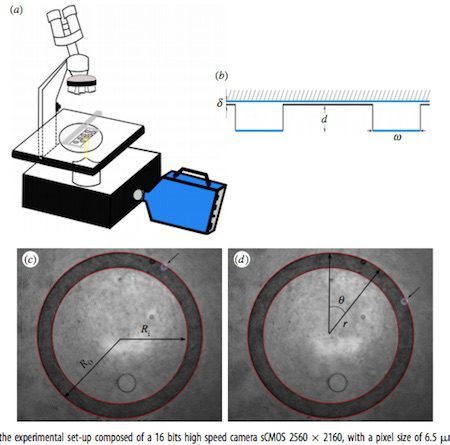
(Thanks to Bob O’Hara for bringing this to our attention.)

Podcast 85: Jean Berko Gleason’s disgusting word list
Jean Berko Gleason is personally disgusted — disgusted, she will have you know! — by certain words. Gleason, one of the world’s great linguistics/psychology researchers, reveals her lovingly collected list of words that disgust her. That’s what you’ll hear in this week’s Improbable Research podcast.
SUBSCRIBE on Play.it, iTunes, or Spotify to get a new episode every week, free.
This week, Marc Abrahams discusses disgusting words — that is, words that disgust one particular person, that person being Boston University psychology professor emerita Jean Berko Gleason. Early in her career, she gained fame for inventing the WUG Test. The WUG test revealed that young children have impressively subtle abilities to learn — and use — new bits of language.
This photo shows Professor Gleason delivering half of the traditional Ig Nobel “Goodbye, Goodbye” speech, at the 2015 Ig Nobel Prize ceremony at Harvard University:
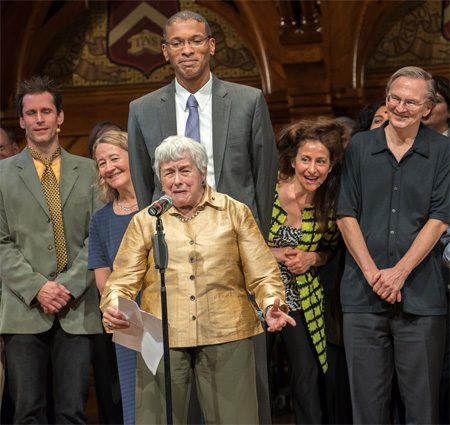
The mysterious John Schedler or the shadowy Bruce Petschek perhaps did the sound engineering this week.
The Improbable Research podcast is all about research that makes people LAUGH, then THINK — real research, about anything and everything, from everywhere —research that may be good or bad, important or trivial, valuable or worthless. CBS distributes it, on the CBS Play.it web site, and on iTunes and Spotify).

October 11, 2016
Tea & coffee diet: Theory of everything
To gain quick fame as a biomedical seer, explain how a person can grow slim (or fat) by drinking coffee (or tea).
This newly published study gives you fodder for devising your Theory of Everything. Good luck!
“Molecular mechanisms of the anti-obesity effect of bioactive compounds in tea and coffee,” by Min-Hsiung Pan, Yen-Chen Tung, Guliang Yang, Shiming Li and Chi-Tang Ho, Food and Function, epub October 10, 2016. The authors explain:
“Obesity is a serious health problem in adults and children worldwide. [Many] researchers have sought to identify bioactive components in food. Tea and coffee are the most frequently consumed beverages in the whole world…. Although the anti-obesity mechanism of tea and coffee still needs further clarification, they may have potential as a new strategy to prevent or treat obesity.”
The study includes this helpful diagram:
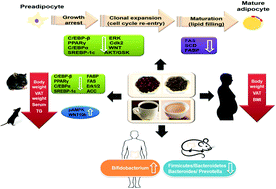
BONUS: Here’s video of the song “The Coffee Diet”:

Those peculiar Harvard Sentences, developed in a basement
Sarah Zhang writes, in Gizmodo, about how “The ‘Harvard Sentences’ Secretly Shaped the Development of Audio Tech“:
During World War II, the boiler room under Harvard’s Memorial Hall was turned into a secretive wartime research lab. Here, volunteers were subjected to hours of noise as scientists tested military communications systems. Out of this came the Harvard sentences, a set of standardized phrases still widely used to test everything from cellphones to VoIP.
Few know about the sentences themselves other than speech scientists and audio engineers, but the technologies they’ve helped build are everywhere. Verizon’s real-life “Can you hear me now?” guy uses them. Speech-to-text software engineers use them. Speech scientists studying cochlear implants say them out loud all the time. “These materials have been the gold standard,” says David Pisoni, director of the Speech Research Laboratory at Indiana University.
Here are some of the Harvard Sentences:
The birch canoe slid on the smooth planks.
Glue the sheet to the dark blue background.
It’s easy to tell the depth of a well.
These days a chicken leg is a rare dish.
Rice is often served in round bowls.
The juice of lemons makes fine punch.
The box was thrown beside the parked truck.
The hogs were fed chopped corn and garbage.
Four hours of steady work faced us.
Large size in stockings is hard to sell.
Memorial Hall, by the way, is the building in which the Ig Nobel Prize ceremony happens every year.
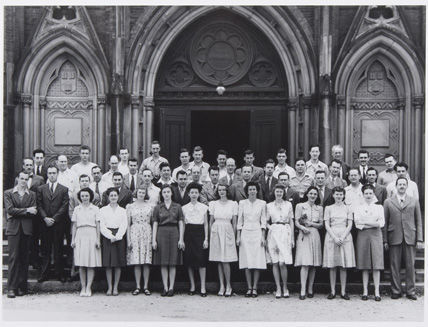

October 10, 2016
Additional co-winners of the 2009 Ig Nobel economics prize have been convicted
Two more of the many co-winners of the 2009 Ig Nobel economics prize have achieved special recognition from the Icelandic government: they have been pronounced guilty in legal proceedings.
BACKGROUND: The 2009 Ig Nobel Prize for economics was awarded to the directors, executives, and auditors of four Icelandic banks — Kaupthing Bank, Landsbanki, Glitnir Bank, and Central Bank of Iceland — for demonstrating that tiny banks can be rapidly transformed into huge banks, and vice versa — and for demonstrating that similar things can be done to an entire national economy. (REFERENCE: Report of the Special Investigation Commission, issued April 12, 2010.)
Last year, 2015, 26 co-winners of the 2009 Ig Nobel economics prize were sentenced to prison.
Now, in October 2016, the Icelandic Monitor reports:
Iceland’s Supreme Court has return a guilty verdict for all nine defendants in the Kaupþing market manipulation case, the court trial for which began in April 2015.
Back in June last year, the Reykjavik District Court found seven of the nine defendants guilty, acquitting two…. The Supreme Court has now overturned the acquittals, finding Björk Þórarinsdóttir (credit representative at Kaupþing) and Magnús Guðmundsson (former CEO of Kaupthing Luxembourg) also guilty alongside the other seven.
The Icelandic Monitor published these photos of the lucky winners:
(Thanks to Beccanalia for bringing this to our attention.)

Charles Hoffman joins Luxuriant Flowing Hair Club for Scientists (LFHCfS)
Charles Hoffman has joined the Luxuriant Flowing Hair Club for Scientists (LFHCfS). He says, not tersely:
I am a molecular geneticist who uses the fission yeast Schizosaccharomyces pombe to study cyclic nucleotide signaling. I am so focused on my research that I rarely notice how long my hair has grown. Every year or two, my daughter insists on cutting it so that it does not reach my waste. I have come to see my hair as part of my “brand”, otherwise I’d be just another short Jewish yeast geneticist.
Charles Hoffman, Ph.D, LFHCfS
Professor of Biology
Boston College
Boston, Massachusetts, USA
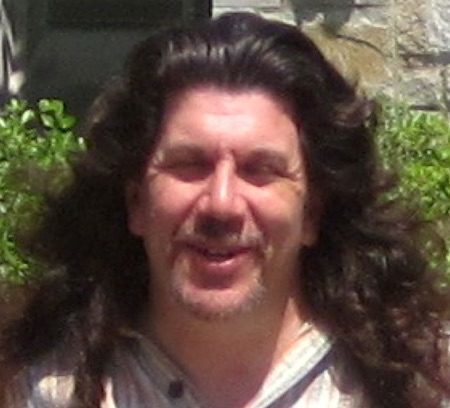

Marc Abrahams's Blog
- Marc Abrahams's profile
- 14 followers





